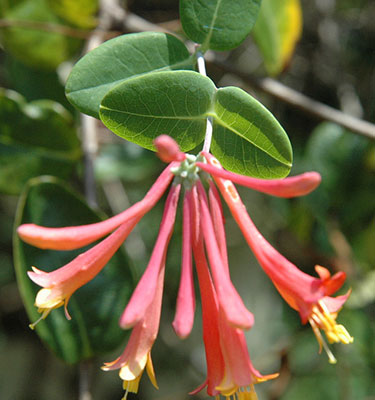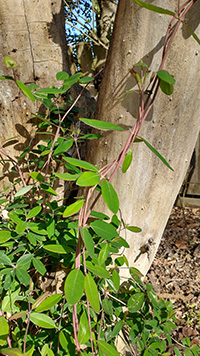Coral Honeysuckle

Need to jazz up a fence or trellis? Our native coral honeysuckle features scarlet flowers that bloom for months. And Florida’s wildlife loves it, too!
Characteristics
Coral honeysuckle (Lonicera sempervirens) grows all over Florida, USDA Hardiness Zones 4 to 10. In Central and South Florida, the leaves are evergreen. In North Florida, the leaves may drop in colder winters.
Also called trumpet honeysuckle, this vine is best known for its bright red, tubular flowers. Clusters of blooms emerge on new growth in spring and summer. The flowers attract hummingbirds and butterflies for months before maturing into berries. These fruits draw songbirds in late summer and fall.
In some cultivars of L. sempervirens the new growth is a soft pink. The leaves are medium-sized and pretty, too. The tops are bright green and in a breeze flash silvery undersides. Improved cultivars are available in some nurseries. ‘Sulphurea’ produces bright yellow flowers. ‘Superba’ has broadly oval leaves. ‘Magnifica’ is late flowering and produces large, bright red blooms.
Coral honeysuckle is a Florida-Friendly alternative to Japanese honeysuckle (L. japonica). Japanese honeysuckle is invasive and typically has white or yellow flowers.
Planting and Care

Since it’s a vine, coral honeysuckle works well on trellises and fences. Individual stems can grow up to 15 feet in length. Training and pruning can help direct these and improve overall form. Honeysuckle can be planted as a ground cover, too. Vines like this one help control erosion on steep slopes.
Coral honeysuckle tolerates most soil types and conditions. It does best in slightly acidic soil but does not tolerate dry sands. It will grow in partial shade, but blooms best in full sun.
Coral honeysuckle is generally a low-maintenance plant once it’s established. It is drought tolerant and does not attract any particular pests.
Gardeners looking for this plant can find it at native plant nurseries. Some conventional nurseries have it in stock as well. You can also propagate new plants from cuttings.
For more information on coral honeysuckle, contact your county Extension office.
